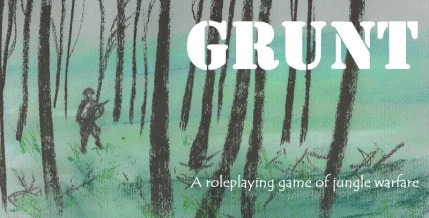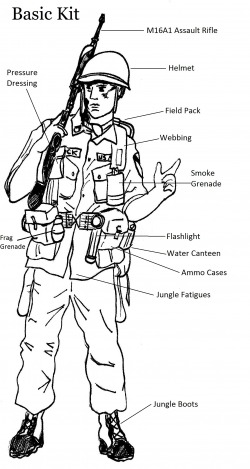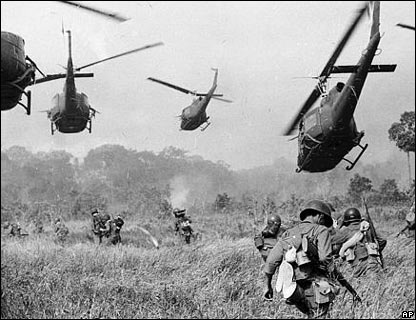Grunt by Traveller
Single Post
Original SA postMaxwell Lord posted:
I believe you left out the best part of the intro:

Cowards in MG, worms in BE, and traitors in BW.
I wonder if Luke Crane wakes up in the middle of the night with 'Nam-like flashbacks of the Tomb of Horrors or something.
Speaking of 'Nam, I think I'll cover Grunt, which is the best Vietnam RPG I've ever come across. Granted, I've only encountered two Vietnam War RPGs (this and the original, pre-Palladium version of RECON), but this remains one of the coolest little RPGs I've ever seen.
So, without further ado:
Grunt: The Roleplaying Game Of Jungle Warfare

Art is sparse, but I love when he breaks out the pastels.
quote:
"You're in the Republic of Vietnam" , said an infantry officer at Bien Hoa to his new recruits. "This is the programme for the day: You're going to get killed in Vietnam."
There it is.
GRUNT has an interesting story. The author, Paul Elliot, is a British historian with an interest in the Vietnam War, and a geek. He ran games about the Vietnam War for his teenage kids (that knew Vietnam as 'the country the Top Gear blokes were in in that one episode' and little else) and posted about his experiences in rpg.net, where he got a positive response. Eventually, he developed the couple of homebrew rules he had into a full game with feedback from the forums, and put it up on DrivethruRPG. So we're basically playing with the ruleset a dad made for his kids. Isn't that sweet?
Well, this is a game where one of the hardcoded rules is "only one PC may die per turn", so you tell me.

The game starts with an overview of Vietnam at the time of the war, the conflict itself, and the American armed forces in the 'Nam. Specifically, the PCs will be part of a platoon in Echo Troop, 1st Squadron, 7th Cavalry Regiment, 1st Cavalry Division. In '65, the division became the first military unit to totally embrace air mobility - while not everything moved by chopper in Vietnam, the 1st Cav certainly did, and by the end of the war they had proved so succesful that they had fought in every military region. The author suggests Apocalypse Now and We Were Soldiers for their portrayals of the 1st Cav. Wait, people actually watched We Were Soldiers?
It follows with a description of aero-rifle platoons, the way ranks work in the field (protip: field sergeants are not drill sergeants), a write up on base camps and how people live in and near one, as well as the specific base camp of the PCs (Camp Radcliff, near An Khe). It's all really interesting and informative, but none of you care about that, you want rules! And here's where the game shines.
Creating a character is easy. First, you give the grunt a name, then his war name (something like Joker, Animal Mother, Mr. Clean... you get the idea) and a single identifying feature, like having a Southern drawl or big blue eyes. You can also roll for the grunt's age, ethnicity and hometown (with a caveat if you end up rolling something like a good Polish boy from Hawaii)
The five stats are Body , Combat , Awareness , Technical and Spirit . They're fairly self-explanatory, and you need to roll 1d3 for each. A grunt with three stats at 1 should be tossed out of the army and the player can reroll again.
There are also five derived stats:
Panic : each time the grunt comes under fire, he needs to roll his Panic score or higher in 2d6. Failure means the character freezes in combat, hugs the ground, sprays bullets wildly, and is generally useless. FNGs almost always freeze up. Each time a grunt survives a mission in which he comes under fire, Panic drops by 2. When it hits 0, the grunt is no longer panicked by incoming fire and starts reacting instinctively. But... there's a catch.
Then there is Max Load (how much stuff other than basic kit the grunt can carry), Max Wounds (how many minor wounds the grunt can take before taking a serious wound and be at death's door) and Stress , that will be better covered in a bit, so let's just say here that it starts at 0.
Now, the grunt gets to choose a role. Each role in the squad comes with one skill in which the grunt must spend one of his initial four skill points, rank, gear and responsibility within the squad. Some roles come with a limit (for instance, there can only be one squad leader). The seven roles are Squad Leader (Staff Sergeant), Team Leader (Sergeant), Grenadier (Specialist), Machinegunner (Specialist), Medic (PFC), Radio Operator (Specialist) and Scout (PFC). Ah, and two of the players must choose the Squad Leader and Team Leader roles, because fuck being bossed around by NPCs. Now, the PC leaders don't have to boss around the others: they'll probably be just as green as the regular grunts anyway, and act more as spokesmen between the line soldiers and the brass.
Skills! They're rated at Qualified (+1) or Expert (+2), with each rank costing one skill point. These are the kind of stuff you would expect out of a modern combat RPG, like Heavy Weapons, Jungle Survival, Mechanic, Medical and so on. One skill that stands out is Scrounge, the skill to get what the squad needs through a long series of under the table deals and bribes. Squad needs claymore mines and the quartermaster doesn't want to play nice? Well, time to peddle some, uh, 'recovered' AKs or something.
Rolls! They can be either open, where the grunt knows if he's succeeded immediately; or secret, where the grunt may never know if he's been successful or not. Open tasks are rolled as 2d6+relevant attribute+relevant skill. Success takes place on a roll of 10+, or 12+ if the GM feels the task is especially difficult. Secret rolls, on the other hand, require the player to roll a number of d6 equal to (relevant attribute+relevant skill)x2. The GM secretly decides a 'magic number' from 1 to 6: if one of the player's dice comes up with the magic number, the task has succeeded. A couple of examples follow for each type of roll; amusingly, the poor grunt fails both.
A list of gear follows. Gear is very abstracted, an assault rifle is an assault rifle whether it's an M16 or an AK. There's also Murphy's Laws of Combat, which are pretty much what you imagine.

quote:
Every player should read these, and try to remember that the Game Master has read them too!
And now, the mission itself. This reads more like a GM section, telling people how to make missions for the game. The main point is putting the grunts in physical danger, giving them a goal, and then putting a serious non-physical obstacle in their path. There's a list of sample goals, covering most classic Vietnam scenarios (follow patrol route, search the ville, take medics to do hearts-and-minds missions, defend the forward base, storm the hill, etc.), as well as some talk on developing personalities for the NPC grunts and villagers. Maps are brought up too - actual field maps, not miniature combat maps. There's an overview of how an average mission plays out, from the insertion by chopper (with either a standard or a 'hot' LZ), how far away from the base the mission can play out, and how the grunts are extracted and what happens after the mission. Don't think I'm skimming these bits because they're boring or irrelevant - this is all really interesting shit, but it doesn't really fit into a FnF post.
For crunch, this section has a checklist for marching across country (with modifiers to Detect Booby Trap/Detect Ambush rolls based on speed and such). Traps are nasty. They can easily kill a grunt but will most likely maim him, which brings up the problem of dealing with wounded and such. The GM is encouraged to
Thank goodness for fast chargen, right guys? There's no fantasy in this fucking Vietnam. Though there are tunnels, so I guess there's 'subterranean'.
Ambushes! Rules for spotting them, ranges for spotting people in the jungle and in dense vegetation, how to spot a sniper, and such. Though to understand these, it's important to know how combat works. Moving on! There's also rules for fire support (only one per mission, and it's not guaranteed, but it deals a fearsome 12d6 damage in the target zone) The XP rules are here as well: they're squad based, the entire squad gets points based on whether they completed the objective, captured useful prisoners, killed enough VC, and so on. The squad loses points for dead grunts and for dead civilians - the latter is important, since the squad needs to kill 10+ VC to make up for the death of a single civilian, so there's a mechanical incentive not to reenact My Lai every time you sit and play. Every 10 and 20 points, the entire squad gets new perks: extra weapons, money for special kit, replacement grunts, skill points, even R&R. And there's medals, too, if you want, but they have no mechanical effect.
Now, Stress. Here's where the game gets really mean. When a grunt faces a horrific scene, he needs to roll 2d6+Spirit. Failure means the grunt gets one Stress point. Stress is always associated with Conditions, behaviors that are not considered normal and that the PC uses to relieve stress. The horrors of war are, like the PDF says, the things your father never told you about his time in Normandy. Mutilated corpses, horrible wounds, body parts, horrific death, torture, human suffering. One particularly nasty example has a doctor working on an Aussie soldier for hours to save his life, only for a VC POW at the same hospital to slice the Aussie's throat with broken glass.
 . Stress can be reduced by roleplaying a scene where the PC can give free rein to their condition(s), and it's important for them to do so - if a grunt ends a session with Stress points, during his next mission his Panic resets to his original score as their fear becomes real and physical. The list of conditions follows, stuff like Fanatical Anti Communist, Nightmares or Post Combat Shakes. You know, shellshock goodness.
. Stress can be reduced by roleplaying a scene where the PC can give free rein to their condition(s), and it's important for them to do so - if a grunt ends a session with Stress points, during his next mission his Panic resets to his original score as their fear becomes real and physical. The list of conditions follows, stuff like Fanatical Anti Communist, Nightmares or Post Combat Shakes. You know, shellshock goodness.
To make things worse, reducing Stress by roleplaying conditions is temporary - next session, the Stress score will be reset back to full strength. The only way to reduce Stress permanently is by Stories . When a PC shows true kindness and humanity towards civilians, comrades, or even VC, the GM may award him with a Story - an anecdote from the grunt's past that reminds him that he's still human. Stuff like "Bob crashed his dad's car the same day he passed his driving test", for instance. The GM is advised not to award them to every grunt and the end of every mission - it will take work, and there may just not be opportunities in a mission to do so. Once the player makes up his Story and shares it with the other players, the player may at any time 'spend' that Story to permanently reduce another grunt's Stress score. And if a grunt dies, his Stories die with him.

Finally, combat. It's split in 10-15 second turns, with actions being generally simultaneous. VCs only have one stat, VC Rating, that varies depending if they're Local Force, Main Force or straight North Vietnamese Army soldiers. The GM must roll the VC Rating or higher to hit one (and only one) PC grunt, and as mentioned at the beginning, there can be only one character casualty per turn. Yeah.

It was this big. Yeah, I know.
Combat is split in three parts: aimed fire , area fire and close combat . Aimed fire is traditional "I see a guy, I shoot him in the face" RPG combat. It's deadly as sin, an open Combat roll with appropriate modifiers, followed by a damage roll if it's successful. Automatic weapons can shoot twice, or even three times in one round. But, since this is the Roleplaying Game of Jungle Warfare, most gunfire will be area fire, where characters direct their fire at a patch of vegetation, a hooch or a street front. Enemies in cover are effectively invisible and can only be hit by area fire. Area fire is resolved, in principle, just like aimed fire - open Combat rolls. But instead of just hitting a guy and rolling damage, each success gives the GM one d6 for his Area Fire Pool. Once everyone has made their rolls. the GM secretly rolls this pool: every 6 is a VC that is severely wounded or killed.
But wait, you say, if VC kills are rolled in secret, how do PCs know if they've hit someone?
They don't.
Maybe the VC continue firing next turn. Maybe they pull back, pause to reload, or just lie in ambush, waiting for the grunts to move out of cover. Maybe the grunt's fire actually suppressed them for a bit. The grunts may want to shoot the area some more - with all the lead they're throwing down the VC's way, they HAVE to hit someone, right? Right?

This is the 'Nam. What do you think?
Finally, there's close combat, when the characters are within 5m of the enemy. It's confusing and chaotic, but if the attackers can survive the 'killing zone' in front of the enemy (where they're exposed to enemy aimed fire) they might as well win out of sheer shock. It's very abstract, the game doesn't track blow by blow or individual positioning, but people armed with close combat weapons (bayonets, shotguns, SMGs, entrenching tools) will be at an advantage.
Damage! Weapons are rated in d6s, just like everything else in the game. Rolls of 1 are ignored; rolls of 2-5 are minor wounds, that stun you for a number of rounds equal to the number of minor wounds you took in that round (or inflict a penalty of -1 in close combat); and 6s are serious wounds, where there's an awful lot of screaming and blood. Two serious wounds result in instant death, but even one is grounds for medevac, treatment and discharge back to the World. There's some miscellaneous rules for ammo (effectively unlimited unless they're cut off from supplies or such), jammed weapons, flanking (the best way to survive a close combat rush), use of mortars and grenades and such.
To round things up, a section on Vietnamese landscape, culture, food, VC organization and tactics, as well as 12 adventure 'seeds' based on The Doors songs. These are much more detailed than your basic RPG plot seed, but they're not blown out to the level of a full adventure. There's action, there's investigation and even some comedy (PC unwittingly accepted a marriage proposal, WAT DO) but The Unknown Soldier takes the cake for grimdark: the squad is ordered to find the body of an American soldier spotted by friendlies from a nearby village. The body is striped naked, partially flayed, face smashed in, eyes missing, and so on. The body belongs to the brother of an NPC grunt according to the dog tags, and the soldier starts taking out his anger on the villagers and shooting people up. Next day, the PCs have to head into a gorge with a camouflaged VC bunker, and beyond it, they'll find 4 graves, with one actually holding the grunt's brother in it. And now their buddy has committed war crimes for something that never happened.

The PDF ends with a Resources chapter, with books, movie and music recommendations: the author takes the opportunity to plug in his own book (Vietnam: Conflict & Controversy), and I'm still boggled that people actually watched We Were Soldiers. There's a glossary (with a separate bit with offensive words, from 'mama-san' downwards), quick reference tables, sample grunts, character sheets and the index. And that's it!

OK, not from the game, but it seemed appropriate.
All in all, a really cool game. It could benefit from a better layout, but it's nowhere near as disorganized as, say, SLA Industries. With some effort, you could adapt it to other battlefields and such, but it's first and foremost a Vietnam War RPG and the rules reflect that.